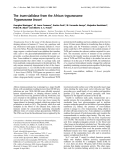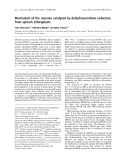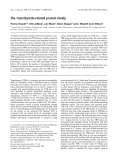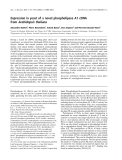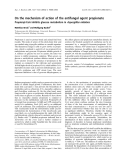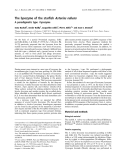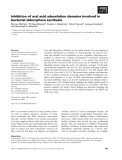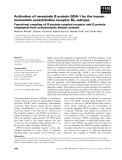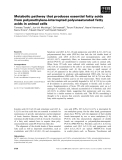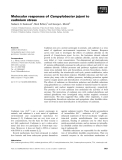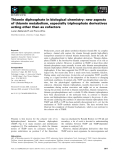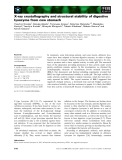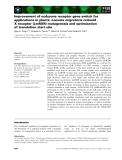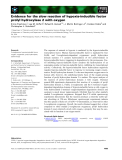
Animal biochemistry
-
Glofish is the first transgenic animal approved to be consumed by human in the USA The insertion of different constructs of GFP into the fish genomes to give different green colors.The idea for recombinant DNA was first proposed by Peter Lobban, a graduate student of Prof. Dale Kaiser in the Biochemistry Department at Stanford University Medical School. The first publications describing the successful production and intracellular replication of recombinant DNA appeared in 1972 and 1973.
 54p
54p  zingzing09
zingzing09
 24-04-2013
24-04-2013
 77
77
 5
5
 Download
Download
-
In diabetic patients, the body does not produce enough insulin or not properly respond to insulin. Insulin is a hormone produced by -cells of the pancreas. It stimulates the cells to absorb the glucose from the blood and its hyposecretion may leads to the over accumulation of glucose in the blood and often leading to various complications.
 82p
82p  spiritedaway36
spiritedaway36
 26-11-2021
26-11-2021
 18
18
 2
2
 Download
Download
-
Trypanosoma brucei is the cause of the diseases known as sleeping sickness in humans (T. brucei ssp. gambiense and ssp. rhodesiense) and ngana in domestic animals (T. brucei brucei) in Africa. Procyclic trypomastigotes, the tsetse vector stage, express a surface-bound trans-sialidase that transfers sialic acid to the glycosylphosphatidylinositol anchor of procyclin, a surface glycoprotein covering the parasite surface. Trans-sialidase is a unique enzyme expressed by a few trypanosomatids that allows them to scavenge sialic acid from sialylated compounds present in the infected host. ...
 10p
10p  system191
system191
 01-06-2013
01-06-2013
 44
44
 4
4
 Download
Download
-
Dehydroascorbate reductase (DHAR) reduces dehydro-ascorbate (DHA) to ascorbate with glutathione (GSH) as the electron donor. We analyzed the reactionmechanismof spinach chloroplast DHAR, which had a much higher reaction specificity for DHA than animal enzymes, using a recombinant enzyme expressed inEscherichia coli. Kinetic analysis suggested that the reaction proceeded by a bi-uni-uni-uni-ping-pong mechanism, in which binding of DHA to the free, reduced formof the enzyme was followed bybindingofGSH....
 8p
8p  tumor12
tumor12
 20-04-2013
20-04-2013
 47
47
 6
6
 Download
Download
-
A number of proteins related to the homotetrameric trans-port protein transthyretin (TTR) forms a highly conserved protein family, whichwe present in an integrated analysis of data from different sources combined with an initial bio-chemical characterization.Homologues of the transthyretin-relatedprotein (TRP) canbe found inawide rangeof species including bacteria, plants and animals, whereas transthyre-tinshave so faronlybeen identified invertebrates.
 15p
15p  tumor12
tumor12
 20-04-2013
20-04-2013
 44
44
 2
2
 Download
Download
-
The herpes simplex virus thymidine kinase⁄ganciclovir (HSV-tk⁄GCV) sys-tem that selectively depletes cells expressing HSV-tk upon treatment with GCV has provided a valuable tool for developing a new animal model expressing the desired tissue damage. In this paper, an HSV-tk vector with an albumin promoter⁄enhancer was constructed. Based on the favourable killing effect on Hep-G2 cells by the recombinant construct, the HSV-tk transgenic mouse strains were developed.
 9p
9p  awards
awards
 06-04-2013
06-04-2013
 53
53
 3
3
 Download
Download
-
During a search for cDNAs encoding plant sterol acyl-transferases, we isolated four full-length cDNAs fromAra-bidopsis thaliana that encode proteins with substantial identity with animal lecithin : cholesterol acyltransferases (LCATs). The expressionof one of these cDNAs,AtLCAT3 (At3g03310), invarious yeast strains resulted in the doubling of the triacylglycerol content.
 13p
13p  awards
awards
 05-04-2013
05-04-2013
 40
40
 4
4
 Download
Download
-
Propionate is used to protect bread and animal feed from moulds. The mode of action of this short-chain fatty acid was studied usingAspergillus nidulansas a model organism. The filamentous fungus is able to grow slowly on propio-nate, which is oxidized to acetyl-CoA via propionyl-CoA, methylcitrate and pyruvate. Propionate inhibits growth of A. nidulanson glucose but not on acetate; the latter was shown to inhibit propionate oxidation.
 15p
15p  awards
awards
 05-04-2013
05-04-2013
 46
46
 3
3
 Download
Download
-
Cn12 isolated from the venom of the scorpionCentruroides noxiushas 67 amino-acid residues, closely packed with four disulfide bridges.Its primary structure and disulfide bridges were determined.Cn12 is not lethal to mammals and arthropodsin vivoat doses up to 100lgper animal.Its3D structure was determined by proton NMR using 850 dis-tance constraints, 36 /angles derived from 36 coupling constants obtained by two different methods, and 22 hydrogen bonds.
 13p
13p  dell39
dell39
 03-04-2013
03-04-2013
 47
47
 3
3
 Download
Download
-
On the basis of a partial N-terminal sequence, Jolle`s and Jolle`s [Jolle`s, J., & Jolle`s, P. (1975)Eur. J. Biochem.54, 19–23] previously proposed that the lysozyme from the starfishAsterias rubensrepresents a new form of lysozyme, called typei(invertebrate) lysozyme. Indeed, it differed from both the typesc(chicken) and g(goose) known in other animals, as well as from plant and phage lysozymes. Recently, several proteins belonging to the same family have been isolated from protostomes. Here we report the com-plete mature protein sequence and cDNA sequence of the lysozyme from Asterias. ...
 6p
6p  dell39
dell39
 03-04-2013
03-04-2013
 42
42
 2
2
 Download
Download
-
Aryl acid adenylation domains are the initial enzymes for aryl-capping of catecholic siderophores in a plethora of microorganisms. In order to over-come the problem of iron acquisition in host organisms, siderophore bio-synthesis is decisive for virulence development in numerous important human and animal pathogens.
 11p
11p  dell39
dell39
 27-03-2013
27-03-2013
 29
29
 3
3
 Download
Download
-
Signal transduction mediated by heterotrimeric G proteins regulates a wide variety of physiological functions. We are interested in the manipulation of G-protein-mediating signal transduction using G-protein-coupled receptors, which are derived from evolutionarily distant organisms and recognize unique ligands.
 9p
9p  inspiron33
inspiron33
 23-03-2013
23-03-2013
 49
49
 5
5
 Download
Download
-
Sciadonic acid (20:3D-5,11,14) and juniperonic acid (20:4 D-5,11,14,17) are polyunsaturated fatty acids (PUFAs) that lack the D-8 double bond of arachidonic acid (20:4 D-5,8,11,14) and eicosapentaenoic acid (20:5 D-5,8,11,14,17), respectively.
 10p
10p  galaxyss3
galaxyss3
 19-03-2013
19-03-2013
 43
43
 2
2
 Download
Download
-
Cadmium ions are a potent carcinogen in animals, and cadmium is a toxic metal of significant environmental importance for humans. Response curves were used to investigate the effects of cadmium chloride on the growth of Camplyobacter jejuni. In vitro, the bacterium showed reduced growth in the presence of 0.1 mmcadmium chloride, and the metal ions were lethal at 1 mmconcentration.
 13p
13p  vinaphone15
vinaphone15
 28-02-2013
28-02-2013
 55
55
 2
2
 Download
Download
-
Prokaryotes, yeasts and plants synthesize thiamin (vitamin B1) via complex pathways. Animal cells capture the vitamin through specific high-affinity transporters essential for internal thiamin homeostasis. Inside the cells, thi-amin is phosphorylated to higher phosphate derivatives. Thiamin diphos-phate (ThDP) is the best-known thiamin compound because of its role as an enzymatic cofactor.
 9p
9p  viettel02
viettel02
 22-02-2013
22-02-2013
 32
32
 3
3
 Download
Download
-
In ruminants, some leaf-eating animals, and some insects, defensive lyso-zymes have been adapted to become digestive enzymes, in order to digest bacteria in the stomach. Digestive lysozyme has been reported to be resis-tant to protease and to have optimal activity at acidic pH. The structural basis of the adaptation providing persistence of lytic activity under severe gastric conditions remains unclear.
 9p
9p  viettel02
viettel02
 22-02-2013
22-02-2013
 38
38
 3
3
 Download
Download
-
The discovery that microRNAs (miRNAs) are synthesized as hairpin-con-taining precursors and share many features has stimulated the development of several computational approaches for identifying new miRNA genes in various animal species.
 7p
7p  viettel02
viettel02
 22-02-2013
22-02-2013
 41
41
 3
3
 Download
Download
-
Gene switches have potential applications for the regulation of transgene expression in plants and animals. Recently, we have developed a two-hybrid ecdysone receptor (EcR) gene switch using chimera 9 [CH9, a chi-mera between helices 1–8 ofHomo sapiensretinoid X receptor (HsRXR) and helices 9–12 ofLocusta migratoriaRXR (LmRXR)] as a partner for Choristoneura fumiferanaEcR (CfEcR).
 11p
11p  viettel02
viettel02
 19-02-2013
19-02-2013
 32
32
 2
2
 Download
Download
-
The response of animals to hypoxia is mediated by the hypoxia-inducible transcription factor. Human hypoxia-inducible factor is regulated by four Fe(II)- and 2-oxoglutarate-dependent oxygenases: prolyl hydroxylase domain enzymes 1–3 catalyse hydroxylation of two prolyl-residues in hypoxia-inducible factor, triggering its degradation by the proteasome.
 11p
11p  viettel02
viettel02
 19-02-2013
19-02-2013
 15
15
 3
3
 Download
Download
-
Activation of peroxisome proliferator-activated receptor (PPAR)-c sup-presses proliferation of rat pulmonary artery smooth muscle cells (PASMCs), and therefore ameliorates the development of pulmonary hypertension in animal models. However, the molecular mechanisms under-lying this effect remain largely unknown.
 8p
8p  mobifone23
mobifone23
 18-01-2013
18-01-2013
 39
39
 2
2
 Download
Download
CHỦ ĐỀ BẠN MUỐN TÌM










